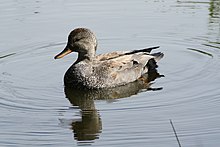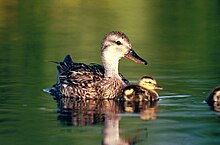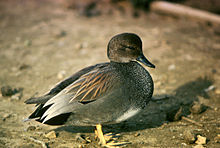Gadfly
| Gadfly | ||||||||||||
|---|---|---|---|---|---|---|---|---|---|---|---|---|

Gadfly ♂ ( Mareca strepera ) |
||||||||||||
| Systematics | ||||||||||||
|
||||||||||||
| Scientific name | ||||||||||||
| Mareca strepera | ||||||||||||
| ( Linnaeus , 1758) |
The Gadwall ( Mareca strepera ), Syn. Anas strepera , in older literature also means duck or Knarrente called, is a species from the family of ducks (Anatidae). The now ancient term mean duck expresses that their body size is between that of the smaller European duck species and the mallard. The term gadfly, on the other hand, indicates how they eat. However, this does not differ from that of other founding elents . The gadfly was first scientifically described by Carl von Linné in 1758 .
The males of the gadfly are inconspicuous in their splendid plumage and resemble the females of the actual ducks from a distance . The only striking feature of the drake is the scale pattern in delicate gray tones, which is only noticeable up close.
The gadfly, for which no subspecies are distinguished, is not a very common breeding and annual bird in the entire Central European area. She is also a regular and sometimes frequent pull-through on her journey to the wintering quarters and back. In northeastern Central Europe there is an increasing tendency to overwinter of this type.
Appearance
Appearance of fully grown gadgets
The 44 to 55 cm tall gadfly weighs 500 to 1300 g and has a wingspan of up to 95 cm. It is thus slightly smaller than the mallard, which it is very similar in habit. The gadfly is a bit slimmer than this one, however.
The male has a black beak in a splendid dress, plumage with fine patterns in gray and brown and a light, almost white belly. The head has a dark brown head plate. Otherwise the head is light brown with reddish brown spots and stripe-like markings. The front chest, the front back, and the shoulders and flanks are dark gray. The back is pinnate medium brown and has lighter speckles. The feet are yellow-orange. The gorgeous plumage is therefore a little more plainly colored than that of the elephants of other European green elves. In the plain dress, the male resembles the female. The females of the gadfly are very similar to those of the mallard. Overall, however, they are a bit more delicate. The short and light orange-yellow beak as well as the white chin and throat are sure differentiators.
The legs of both sexes are orange-yellow and the eyes are black in color. In flight, gadgets can be recognized by their light belly and their striking white wing mirror. Only the wigeon has a comparable white section on the upper wings. In this species, however, it is limited to the forewings and only occurs in the male. The black end of the body of the male is considered the most important field identifier of the gadfly, which is also recognizable when the white mirror is hidden under the folded wings of resting gypsies.
Gadgets can reach an age of up to 13 years.
Appearance of the downy chicks and fledglings
The downy chicks have a dark brown headstock, an equally colored rear neck and back. A dark line runs from the beak to the headstock. Another dark brown line of paint runs from the base of the beak over the eye to the neck. Some downy chicks have a diffuse dark spot on the back of the head at the level of the ears. The sides of the head, the lower body and individual parts of the wings are creamy white.
At the time of hatching, the upper beak on the ridge is dark gray. The upper bill sides are flesh-colored. The nail is brownish pink. The lower mandible is completely flesh-colored. The legs and feet are dark gray, with the sides of the legs slightly lighter. The webbed feet are black. They differ from mallard ducks of the same age in that they have a different beak color. The downy chicks of the mallard are also significantly more yellow, especially in the face.
By the time the young gadfly fledglings, the initially flesh-colored areas of the beak have turned yellow. Legs and feet are dull yellow. The webbed feet are gray in color.
voice
The call repertoire of the gadfly is very similar to that of the mallard. The males court together and let out a rough nasal ärp or träp , which is very reminiscent of the calls of the mallards. In addition, there is a grunt whistle that often rises sharply at the end and is piercingly shrill. This can also be found in the mallard, but the whistle of the gadfly is lighter in tone. Characteristic of the females are rääk-rääk-rääk call series, which decrease in pitch as well as volume. This call is also found in a similar form in female mallards.
Distribution and existence
The gadfly is a partially Holarctic species that also breeds in the western Palearctic in temperate climates. Its breeding area runs from Iceland across Great Britain, where it belongs to the fauna of Scotland , across southern Scandinavia and Central Europe. In Iceland it occurs almost exclusively on Lake Myvatn . It is less common in Central Europe than in Asia and North America. The breeding areas are always disjoint in these regions, which has to do with their special demands on breeding areas. In appropriate places it occurs in large numbers in Western and Central Europe. In the Netherlands, France and Spain, the gadfly breeds only in a few isolated areas. The breeding sites in France and Spain are not regularly occupied. In northern Europe, their breeding occurrence is limited to Denmark (with a focus on the southern part of the country) and relatively scattered in the south of Sweden and Finland. In Germany the gadfly is a regular breeding bird of the coastal hinterland of the North Sea (especially waters in Kögen), the Schleswig-Holstein and Mecklenburg Lake District as well as the Bodden coast and the river valleys of Western Pomerania. Frequency and population density in northern Germany show an increase from west to east. The occurrences continue in Poland. Lake Neusiedl is one of the lakes inhabited by the gadfly and is one of the few steppe lakes in Europe. It also breeds in northern and southern Bohemia and Moravia.
Starting from Masuria in Poland, the northern border of its distribution runs in an easterly direction over the Smolensk-Moscow line to the central Urals. In southern Siberia and Central Asia, the gadfly is a breeding bird of the extensive lake areas of the low-precipitation continental steppes of Asia. It is also a common breeding bird in North America. The main area of distribution is here in the so-called Prairie Pothole region . However, their breeding area extends across Canada to parts of Alaska. Louisiana is one of their most important North American wintering areas .
The Camargue is one of the wintering places for Central and Western European breeding birds. The breeding birds of Eastern Europe overwinter in the Black Sea area and further south. The breeding birds in the north of Great Britain overwinter in Ireland. Breeding birds in southern Great Britain, on the other hand, overwinter in Brittany, the Bay of Biscay, the Camargue, Italy, the Netherlands and Denmark. The breeding birds of northern Germany, Poland, southern Scandinavia and western Russia overwinter mainly in the Netherlands and Great Britain, but occasionally also in the Mediterranean area. In the south of Central Europe there is an increasing tendency to overwinter.
According to ornithologists John Gooders and Trevor Boyer, extreme droughts in southern Russia in the 19th century, which led to the migration of the duck species to Europe, are responsible for the incomplete distribution in Europe. There was a second invasive spreading movement from 1929, which among other things led to settlements in Baden-Württemberg, at the Ismaninger reservoir and to a strong increase at the Neusiedlersee. Overall, there was a partly small, in some areas also strong population increase in Central Europe until the middle and end of the 1990s.
According to Hartmut Kolbe, the gadfly is one of the animal species that benefit from global warming. The expansion of the habitable habitat has resulted in an increase in populations. The ornithologist Erich Rutschke sees one reason for the observed population increase in the improved wintering conditions. In the Camargue, for example, the gadfly benefits from the increase in submerged vegetation in shallow water areas, which is a result of unintended nutrient input. A research team that, on behalf of the British environmental authority and the RSPB, examined the future development of birds on the basis of climate models, however, assumes that the gadfly will disappear over a wide area in Western and Central Europe by the end of the 21st century becomes. According to this forecast, the distribution area will decrease significantly and shift to the north.
In North America, almost 2 million gadgets are counted during the winter half-year; in western and southern Europe as well as the European part of Russia there are between 60,000 and 96,000 breeding pairs. The main area of distribution is in Russia. Between 13,000 and 18,000 breeding pairs breed in Central Europe.
habitat
The gadfly is a breeding bird on shallow lakes and ponds with well-developed underwater vegetation. At larger inland lakes, it concentrates on the shallow water zone of these lakes. In the steppe it can be found on the brackish inland waters. It prefers to breed on the bank zones that are not forested and shows a preference for breeding in colonies of gulls. It is completely absent in the mountains. These specific requirements for the breeding area are only met in a few places in Europe, which presumably contributes to the disjoint European occurrence.
nutrition
The gadfly feeds mainly on aquatic plants such as spawning herbs as well as the seeds and rhizomes of sedge and green parts of meadow grasses. Water insects , molluscs , amphibians , beetles , worms and small fish are only taken up to a small extent .
The day and nocturnal gadgets prefer to take their food from the surface of the water or see through the water. They also root, but less frequently than the mallard . In part, it is a regular food parasite in diving swimming birds such as the coot .
Reproduction

Basically, the gadfly is a very well tolerated species that tolerates breeding birds of its own as well as other species in the immediate vicinity of its nest. It therefore breeds in a colony-like manner in some lakes. The distance to the next gadfly nest is sometimes only one meter.
The gadfly basically leads a monogamous seasonal marriage. In the case of very high population numbers, however, many foreign mating with mated males are typical. The courtship occurs predominantly during the time when the gadfly is still in its wintering area. During courtship, the drake swimming on the water shows the black end of its body by lifting it out of the water. It also fans out its white mirror on the wings, creating a striking pattern. At the same time he raises and lowers his head. The gadfly courtship repertoire also includes row flights , in which mostly a single male tries to squeeze between a pair. At the beginning of the breeding season, however, such pursuit flights can also often be observed as a territory defense.
When the ducks return to their breeding grounds in April, they are usually already mated. The gadfly breeds from May to July. Their bottom nest is well hidden in the dense vegetation in the bank region of a shallow still water .
The nest is always built on a dry surface. Islands are preferred. The nests are usually built in the immediate vicinity of the water and are very rarely more than six meters from the shore. The nest is always a simple bowl-shaped structure made of material that the female can reach while sitting. The nest is usually padded with down feathers. These are dark with a light center and conspicuously light tips. The clutch usually consists of eight to 12 eggs. In exceptional cases there are also sixteen eggs in a nest. The eggs are elliptical to almost oval in shape. They are cream-colored to pale green. The female breeds alone. The incubation begins after the last egg has been deposited. The incubation period is 25 to 27 days.
The young birds flee the nest and are able to swim immediately. They are looked after by the female alone. They fledge after seven weeks. On average, five to six young of a brood grow up. The young birds are sexually mature after about one year of life.
Keeping as ornamental poultry
The inconspicuous ducks with their calm way of life are rarely kept as ornamental fowl by breeders. In contrast, they can be observed in zoos and bird parks.
Others
In 1874 two specimens of a duck with great resemblance to the gadfly were caught on Teraina in the South Pacific and then described in the scientific literature as the subspecies " Anas strepera couesi ". Today we are sure that this was not a subspecies of its own, but that young gadgets have drifted to this island.
The gadfly is a monotypical species. Both morphological and mtDNA data consistently indicate a close relationship between gadfly, sickle and wigeon .
supporting documents
Individual evidence
- ↑ Rutschke, p. 184.
- ↑ Viktor Wember: The names of the birds in Europe - meaning of the German and scientific names. Aula-Verlag, Wiebelsheim 2007, ISBN 978-3-89104-709-5 , p. 83.
- ↑ Bauer et al., P. 84.
- ↑ Collin Harrison, Peter Castell: Field Guide Bird Nests, Eggs and Nestlings. revised edition. HarperCollins Publisher, 2002, ISBN 0-00-713039-2 , p. 72.
- ^ Hans-Heiner Bergmann, Hans-Wolfgang Helb, Sabine Baumann: The voices of the birds of Europe - 474 bird portraits with 914 calls and chants on 2,200 sonograms. Aula-Verlag, Wiesbaden 2008, ISBN 978-3-89104-710-1 , p. 54.
- ↑ Rutschke, p. 186.
- ↑ Hans Meltofte, Jon Fjeldså: Fuglene i Danmark . Gyldendal, København 2009, ISBN 978-87-00-79622-5 , p. 163.
- ↑ Knarand (Anas strepera). at: dofbasen.dk
- ^ Sören Svensson, Mikael Svensson, Martin Tjernberg: Svensk fågelatlas . Vår Fågelvärld, supplement 31, Stockholm (1999), pp. 62-63 Sveriges ornitologiska förening ISBN 91-88124-18-5 .
- ↑ Gadwall (Anas strepera). in the Finnish Breeding Bird Atlas.
- ^ Rudolf K. Berndt, Bernd Koop, Bernd Struwe-Juhl: Vogelwelt Schleswig-Holstein. Volume 5: Breeding Birds Atlas. 2nd Edition. Wachholtz-Verlag, Neumünster 2000, ISBN 3-529-07305-9 , pp. 88-89.
- ↑ Horst Zimmermann: Gadfly (Anas strepera). In: Ornithological Working Group Mecklenburg-Western Pomerania (OAMV) eV (Hrsg.): Atlas of the breeding birds in Mecklenburg-Western Pomerania . Steffen-Verlag, Friedland 2006, ISBN 3-937669-66-3 , pp. 68-69.
- ↑ Dietrich Sellin, Bernd Schirmeister: On the occurrence of the gadfly Anas strepera in the Peenetalmoor near Anklam between 2002 and 2004 . Ornithological Circular Mecklenburg-Western Pomerania, Vol. 45 (2005), pp. 175–187.
- ↑ Rutschke, p. 186.
- ↑ Christopher S. Smith: Field Guide to Upland Birds and Waterfowl. Wilderness Adventure Press, Belgrade (Montana) 2000, ISBN 1-885106-20-3 , p. 62.
- ^ Bauer et al., P. 85.
- ↑ Gooders and Boyer, p. 40.
- ^ Bauer et al., P. 85.
- ^ Bauer et al., P. 85.
- ↑ Rutschke, p. 189.
- ^ Brian Huntley, Rhys E. Green, Yvonne C. Collingham, Stephen G. Willis: A Climatic Atlas of European Breeding Birds. Durham University, The RSPB and Lynx Editions, Barcelona 2007, ISBN 978-84-96553-14-9 , p. 77.
- ↑ Bauer et al., P. 84.
- ↑ Rutschke, p. 186.
- ↑ Gooders and Boyer, p. 41.
- ↑ Rutschke, p. 187.
- ^ Bauer et al., P. 86.
- ↑ Gooders and Boyer, p. 41.
- ^ Bauer et al., P. 86.
- ↑ Collin Harrison, Peter Castell: Field Guide Bird Nests, Eggs and Nestlings. revised edition. HarperCollins Publisher, 2002, ISBN 0-00-713039-2 , p. 70.
- ↑ Collin Harrison, Peter Castell: Field Guide Bird Nests, Eggs and Nestlings. revised edition. HarperCollins Publisher, 2002, ISBN 0-00-713039-2 , p. 70.
- ↑ Gooders and Boyer, p. 41.
- ↑ Bauer et al., P. 84.
literature
- Hans-Günther Bauer, Einhard Bezzel , Wolfgang Fiedler (eds.): The compendium of birds in Central Europe: Everything about biology, endangerment and protection. Volume 1: Nonpasseriformes - non-sparrow birds. Aula-Verlag, Wiebelsheim / Wiesbaden 2005, ISBN 3-89104-647-2 .
- John Gooders, Trevor Boyer: Ducks of Britain and the Northern Hemisphere. Dragon's World, Surrey 1986, ISBN 1-85028-022-3 .
- Hartmut Kolbe: The world's ducks . Ulmer Verlag, Stuttgart-Hohenheim 1999, ISBN 3-8001-7442-1 .
- Erich Rutschke: Europe's wild ducks - biology, ecology, behavior. Aula Verlag, Wiesbaden 1988, ISBN 3-89104-449-6 .
Web links
- Mareca strepera inthe IUCN Red List of Threatened Species 2017.1. Listed by: BirdLife International, 2016. Retrieved August 18, 2017.
- Videos, photos and sound recordings of Anas strepera in the Internet Bird Collection
- Gadfly feathers




